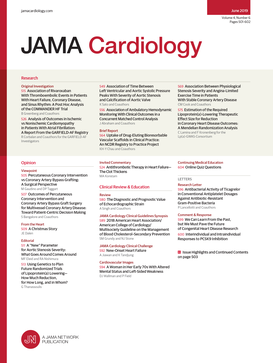Exploring the Link Between Genetic Predictors of Cardiovascular Disease and Psoriasis.
IF 14.8
1区 医学
Q1 CARDIAC & CARDIOVASCULAR SYSTEMS
引用次数: 0
Abstract
Importance The epidemiological link between immune-mediated diseases (IMIDs) and cardiovascular disease has often been attributed to systemic inflammation. However, the direction of causality and the biological mechanisms linking cardiovascular disease with IMIDs are incompletely understood. Given the robust epidemiological association and the growing body of supportive mechanistic evidence, psoriasis is an exemplary IMID model for exploring this relationship. Objective To assess the bidirectional relationships between genetic predictors of psoriasis and the 2 major forms of cardiovascular disease, coronary artery disease (CAD) and stroke, and to evaluate the association between genetic predictors of cardiovascular disease with 9 other IMIDs. Design, Setting, and Participants This was a genetic association study using mendelian randomization (MR), a powerful genetic tool to help distinguish causation from associations observed in epidemiological studies, to provide supportive evidence for causality between traits. The study conducted 2-sample MR analyses using summary-level data from large-scale genome-wide association meta-analysis studies (GWAS) for each trait. The analysis focused on individuals of European descent from GWAS meta-analyses, involving CAD, stroke, psoriasis, and 9 other IMIDs. Data were analyzed from January 2023 to May 2024. Exposures Genetic predictors of CAD, stroke, psoriasis, and 9 other IMIDs. Main Outcomes and Measures The primary outcomes were the associations of genetic predictors of CAD and stroke with the risk of psoriasis and 9 other IMIDs, determined using inverse-variance weighted (IVW) MR estimates. Results This study included 181 249 cases and 1 165 690 controls with CAD, 110 182 cases and 1 503 898 controls with stroke, 36 466 cases and 458 078 controls with psoriasis, for a total of approximately 3 400 000 individuals, and 9 other IMIDs. In contrast to previous assumptions, genetic predictors of psoriasis were found to have no association with CAD or stroke. In the reverse direction, genetic predictors of both CAD (MR estimate IVW odds ratio [OR], 1.07; 95% CI, 1.04-1.10; P = .003) and stroke (IVW OR, 1.22; 95% CI, 1.05-1.41; P = .01) were found to have risk-increasing associations with psoriasis. Adjusting for stroke rendered the associations of genetically predicted CAD with psoriasis risk nonsignificant (and vice versa), suggesting that a shared effect underlying genetic risk for CAD and stroke associates with increased psoriasis risk. No risk-increasing associations were observed for genetic predictors of cardiovascular disease with other common IMIDs, including rheumatoid arthritis and inflammatory bowel disease. Conclusions and Relevance Findings of this mendelian randomization study indicate that genetic predictors of cardiovascular disease were associated with increased psoriasis risk with no reciprocal effect or association with other IMIDs. Elucidating mechanisms underpinning this association could lead to novel therapeutic approaches in both diseases.探索心血管疾病遗传预测因素与牛皮癣之间的联系。
重要性免疫介导疾病(IMIDs)与心血管疾病之间的流行病学联系通常被归因于全身性炎症。然而,人们对因果关系的方向以及心血管疾病与免疫介导疾病之间的生物机制尚不完全清楚。目的 评估银屑病遗传预测因子与冠状动脉疾病(CAD)和中风这两种主要心血管疾病之间的双向关系,并评估心血管疾病遗传预测因子与其他 9 种 IMIDs 之间的关系。设计、设置和参与者这是一项遗传关联研究,使用亡羊补牢随机化(MR)这一强大的遗传工具来帮助区分流行病学研究中观察到的因果关系和关联关系,从而为性状之间的因果关系提供支持性证据。该研究利用大规模全基因组关联荟萃分析研究(GWAS)中针对每个性状的摘要级数据进行了 2 样本 MR 分析。分析的重点是来自 GWAS 元分析的欧洲后裔,涉及 CAD、中风、银屑病和其他 9 种 IMID。主要结果和测量方法主要结果是使用逆方差加权(IVW)MR估计值确定的CAD和中风遗传预测因素与银屑病和其他9种IMIDs风险的关联。结果这项研究纳入了 181 249 例 CAD 患者和 1 165 690 例对照者、110 182 例中风患者和 1 503 898 例对照者、36 466 例银屑病患者和 458 078 例对照者(共计约 3 400 000 人)以及 9 种其他 IMIDs。与之前的假设相反,研究发现银屑病的遗传预测因子与冠心病或中风没有关联。相反,CAD(MR 估计 IVW 比值比 [OR],1.07;95% CI,1.04-1.10;P = .003)和中风(IVW 比值比 [OR],1.22;95% CI,1.05-1.41;P = .01)的遗传预测因子与银屑病的风险增加。对中风进行调整后,遗传预测的 CAD 与银屑病风险的相关性不显著(反之亦然),这表明 CAD 和中风遗传风险的共同效应与银屑病风险的增加有关。心血管疾病的遗传预测因子与其他常见的 IMIDs(包括类风湿性关节炎和炎症性肠病)没有发现风险增加的关联。结论和相关性这项亡羊补牢式随机研究的结果表明,心血管疾病的遗传预测因子与银屑病风险增加有关,但与其他 IMIDs 没有互惠效应或关联。阐明这种关联的机制可为这两种疾病带来新的治疗方法。
本文章由计算机程序翻译,如有差异,请以英文原文为准。
求助全文
约1分钟内获得全文
求助全文
来源期刊

JAMA cardiology
Medicine-Cardiology and Cardiovascular Medicine
CiteScore
45.80
自引率
1.70%
发文量
264
期刊介绍:
JAMA Cardiology, an international peer-reviewed journal, serves as the premier publication for clinical investigators, clinicians, and trainees in cardiovascular medicine worldwide. As a member of the JAMA Network, it aligns with a consortium of peer-reviewed general medical and specialty publications.
Published online weekly, every Wednesday, and in 12 print/online issues annually, JAMA Cardiology attracts over 4.3 million annual article views and downloads. Research articles become freely accessible online 12 months post-publication without any author fees. Moreover, the online version is readily accessible to institutions in developing countries through the World Health Organization's HINARI program.
Positioned at the intersection of clinical investigation, actionable clinical science, and clinical practice, JAMA Cardiology prioritizes traditional and evolving cardiovascular medicine, alongside evidence-based health policy. It places particular emphasis on health equity, especially when grounded in original science, as a top editorial priority.
 求助内容:
求助内容: 应助结果提醒方式:
应助结果提醒方式:


